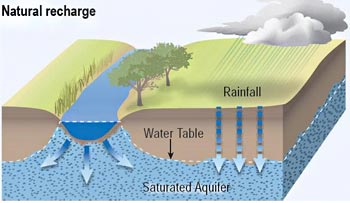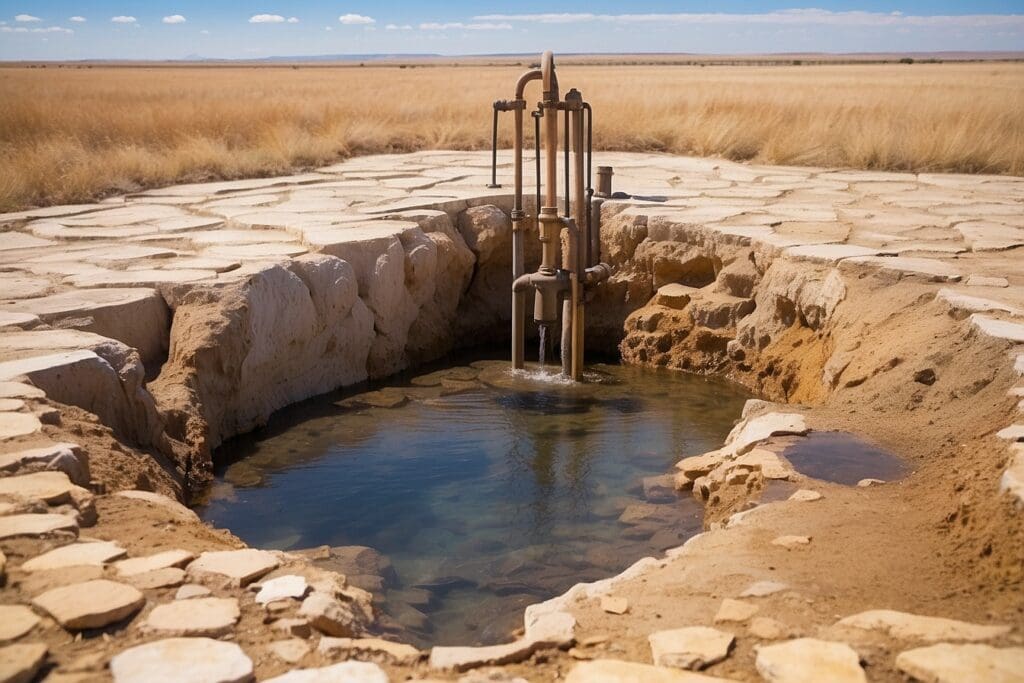Gazing across the oceans and the seas, the prospect of life’s most precious substance always seems to be tantalizingly close but yet so far. While water covers most of the planet’s surface area, amazingly, only 2.5 percent of the total water supply is considered fresh water usable for human consumption.1 Among this 2.5%, only 1.2% are surface waters. A whopping 68.7% of usable water is derived from glacial melts that end up in our rivers and lakes. The other 30.1% of fresh water comes from ground based sources—amounting to 2.78 million trillion gallons of water from groundwater alone.2 Groundwater is therefore a critical source of fresh water available for human consumption.
 iGroundwater by definition refers to nearly any reservoir of subsurface waters that tends to accumulate in fractures and pores of rocky formations beneath the earth’s surface, which are also known as aquifers.3 The origins of groundwater can be multi-sourced in nature, with approximately a quarter of rainfall in the United States being allocated to groundwater reserves and a large proportion of surface waters originating as glacial melts finding its way into aquifers during its journey over land. As a result, groundwater availability is very much contingent on rainfall and surface water conditions. In the case of the current California drought, a significant percentage of water from agriculture is sourced from groundwater sources and the lack of rain has prevented large aquifers from being refilled for use in agriculture.4
iGroundwater by definition refers to nearly any reservoir of subsurface waters that tends to accumulate in fractures and pores of rocky formations beneath the earth’s surface, which are also known as aquifers.3 The origins of groundwater can be multi-sourced in nature, with approximately a quarter of rainfall in the United States being allocated to groundwater reserves and a large proportion of surface waters originating as glacial melts finding its way into aquifers during its journey over land. As a result, groundwater availability is very much contingent on rainfall and surface water conditions. In the case of the current California drought, a significant percentage of water from agriculture is sourced from groundwater sources and the lack of rain has prevented large aquifers from being refilled for use in agriculture.4
Historical Perspective

The use of groundwater takes us far back in time to some of the earliest civilizations in the world, with mentions of its presence in biblical scripture, and for good reason.5 As surface waters travel their way down to aquifers, layers of granite and sand act as natural filters for contaminants that may be harmful for human consumption. Bacteria most often cling to organic clumped masses as they travel on the surface, and such impurities are quite easily removed by simple filtration. Indeed, nature’s design of purifying water for consumption is massively implemented in drinking water plants as flocculation and multiple filtration stages.6 In addition, the storage of water underground is useful against evaporative loss of and includes a significant quantity of dissolved minerals such as magnesium, sodium, potassium that are physiological essentials.7
Modern Context
Industrialization and growth in human activity has undoubtedly introduced various complexities to the extracting of safe drinking water. The unregulated dumping of industrial waste into surface water such as rivers,8 as well as, Perhaps one of the most well characterized examples of groundwater pollution can be found in Bangladesh, which has been dubbed the largest mass poisoning in human history.9 Due to natural arsenic content of soils and industrial sources in Bangladesh, 1 out of every 10 individuals exposed to water concentration levels found in Bangladesh of 500ug/L will ultimately develop serious health complications including lung, bladder and skin cancers. Although one of the more extreme cases of groundwater contamination, a greater degree of vigilance is necessary as human activity continues to encroach upon natural processes that act to restore underground aquifers.
How Groundwater Works
To better understand the modern context of groundwater access, it is best to begin understanding the ways in which groundwater is collected. Most groundwater is extracted through manmade wells that can be generally classified into three types: 1) drilled wells, 2) driven wells, and 3) dug wells.10 All three categories of wells, however, operate using the same basic principle of accessing an aquifer and creating pressure differentials although at different capacities.
Dug wells are the most basic form of a well, relying upon a human operator to firstly access a shallow aquifer and furthermore use some vessel to carry up water from the bottom of the well. These types of wells are amongst the most common, and most prone to contamination as shallow sources of drinking water are most easily contaminated by polluted surface waters. Driven wells usually involve mechanically drilling a small inlet into the ground for aquifer access as far as 50 feet deep. These wells rely upon a surface operator using a hand pump to create a pressure gradient that allows for water to move up the inlet pipe, much like a straw for sodas. One can easily relate to this concept by consuming tube well water in some of the more remote towns in the South or Central Californian Valley and feeling sick. Indeed, in most cases people living in these communities have developed some form of resistance to the marginally contaminated groundwater. Finally, drilled wells usually require a large drilling apparatus to reach depths as far as 1000 feet that remain fairly free of surface contamination but are fairly rare in interspersed rural communities.
The nature of wells as limited access points of groundwater sources often creates complications in maintaining the safe state of groundwater. Most city residents identify with surface reservoirs as sources of drinking water, and indeed surface waters are much more easily regulated due to ease of access and the lack of any concentrative effects of contaminants trapped beneath the surface. More rural communities rely on the tapping of groundwater sources. In fact, 26 percent of the water consumed by Americans is groundwater.11 Therefore the stakes are quite high to ensure the safety of groundwater sources in the United States. While most surface water treatment methods can get away with fairly simplistic techniques involving flocculation, filtration and chlorination, groundwater treatment usually involves more selective removal of contaminants using an array of tools and techniques. An example of such a technique would be an air stripping tower that is specially designed to remove volatile organic pollutants such as benzene.12
It was not until 2006 that federal legislation was implemented to regulate groundwater quality under the Groundwater Rule (GWR).13 The goal of GWR was mainly aimed at eliminating pathogenic microbial contaminants from groundwater through the establishment of safe standards.14 While this legislation is certainly a step in the right direction, the rule does not establish standards against inorganic contaminants such as chemical pollutants or heavy metals whose risks at low doses are not as well characterized.
Groundwater remains to be one of the most critical and untapped sources of water available, and a greater emphasis is needed in ensuring its safety as water continues to become a scarce resource in an ever so populated planet. Ultimately, the key to securing the future of groundwater and consequently the future of clean drinking water rests in the implementation of upstream measures to regulate points and non-point emissions, as well continuous monitoring to prevent the accumulation of unknown contaminants in groundwater.





